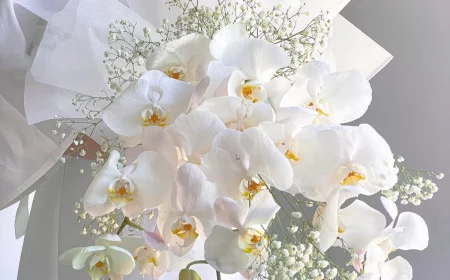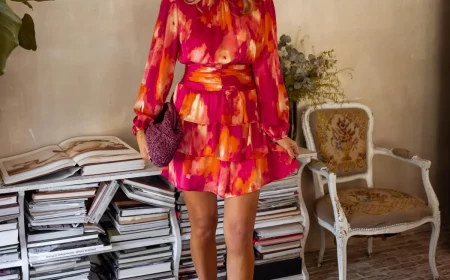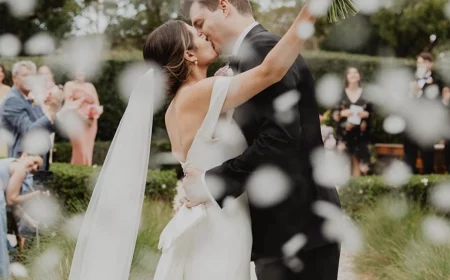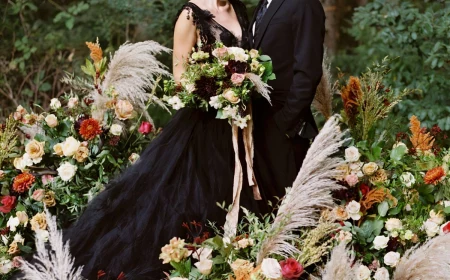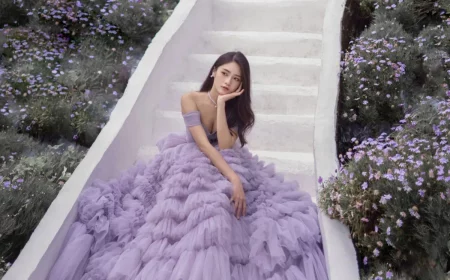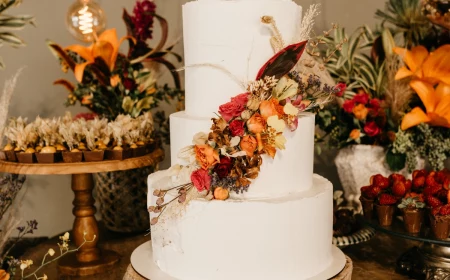Thinking Beyond White? Your Real-Talk Guide to Colored Wedding Dresses
For what feels like forever, choosing a wedding dress color was simple: white or maybe a soft ivory. But let’s be real, that’s changing. More and more, I see brides walking into boutiques with a whole new kind of energy. They’re not just looking for a dress; they’re on a mission to find a color that tells their story—maybe a soft blush, a deep sapphire, or even a show-stopping black. This isn’t just some fleeting trend; it’s about making your big day feel authentically you.
In this article
But choosing a colored gown is a different ballgame. It’s not as simple as picking your favorite shade and calling it a day. The wrong combo of color and fabric can be a costly mistake, but the right one? Absolutely breathtaking. I’ve spent years working with these materials, so I want to share what I’ve learned—from the nitty-gritty technical side to the emotional payoff of getting it just right.
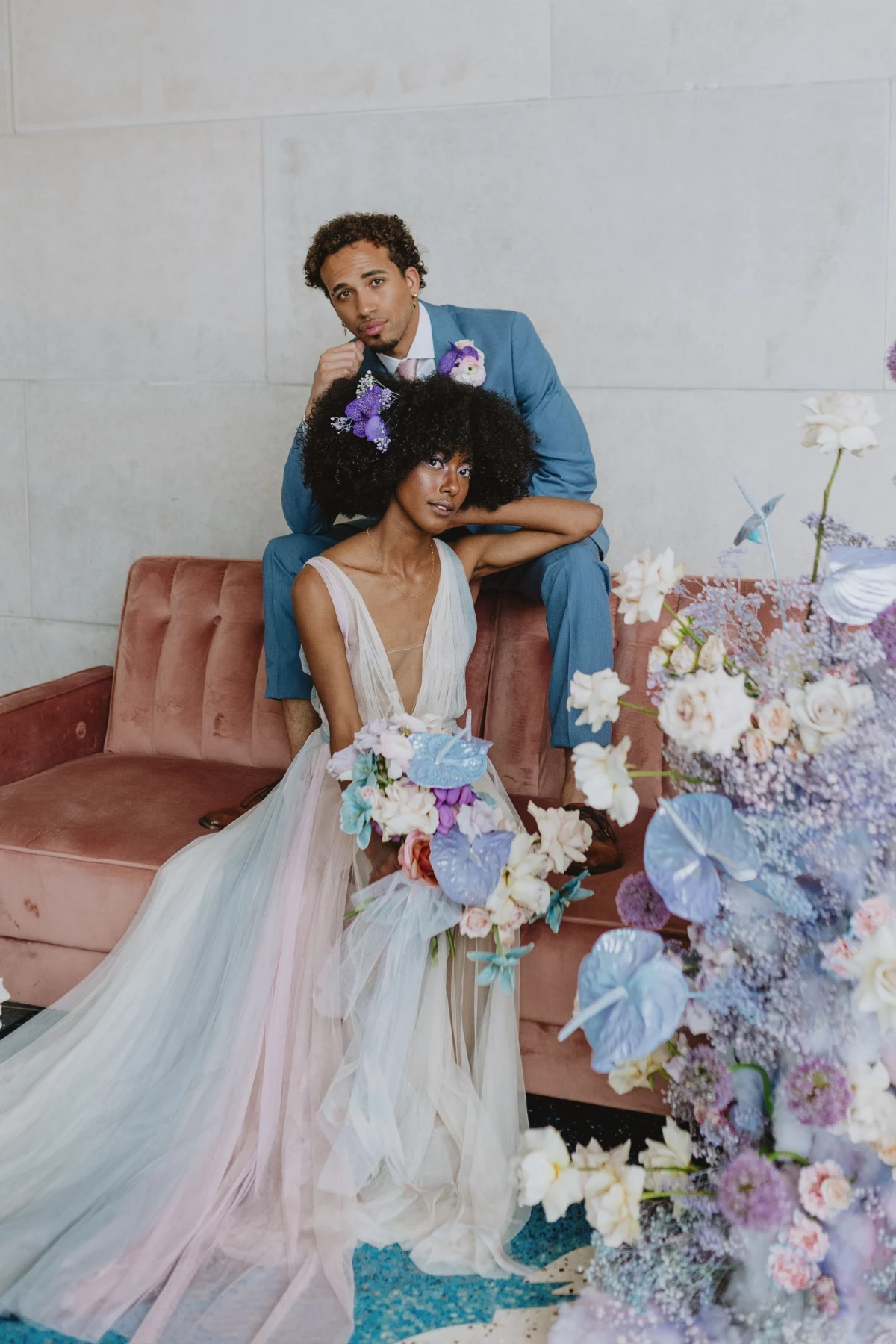
First Thing’s First: Fabric Is Everything
Here’s the absolute most important thing to understand: fabric dictates the final color. You can’t think of them separately. The exact same dye will look wildly different depending on the material it’s on. It’s the secret science behind the art of a stunning colored gown.
Think about it like this: a smooth, shiny fabric like silk satin bounces light back at you. That means a ruby red on satin will look bright, bold, and jewel-toned. But put that same dye on a matte fabric like crepe, and the light gets absorbed. The red will look deeper, softer, and more muted. It’s the same color, but it gives a totally different vibe.
Here’s a quick cheat sheet on how fabrics handle color:
- Satin or Mikado: These have a high sheen, so colors look super vibrant and saturated. A light blue on satin can almost look electric. They have a very formal, classic feel.
- Crepe: This is a matte fabric that soaks up light, making colors look rich and deep. A forest green in crepe is sophisticated and earthy, and it drapes beautifully.
- Chiffon or Organza: Since these are sheer, color is built up in layers. One layer of blush chiffon is barely there, but four layers create a soft, romantic glow. The color feels airy and has a lot of dimension.
- Tulle: Think of tulle as chiffon’s cousin with a more open netting. Color in tulle is incredibly soft and ethereal. It’s perfect for achieving those dreamy, watercolor-like ombre effects where colors blend seamlessly.
- Velvet: Velvet is a game-changer. It has a pile (tiny fibers that stand up), which absorbs and reflects light in a unique way. A navy velvet gown can look almost black in the shadows but a brilliant blue in direct light. The depth is just incredible.
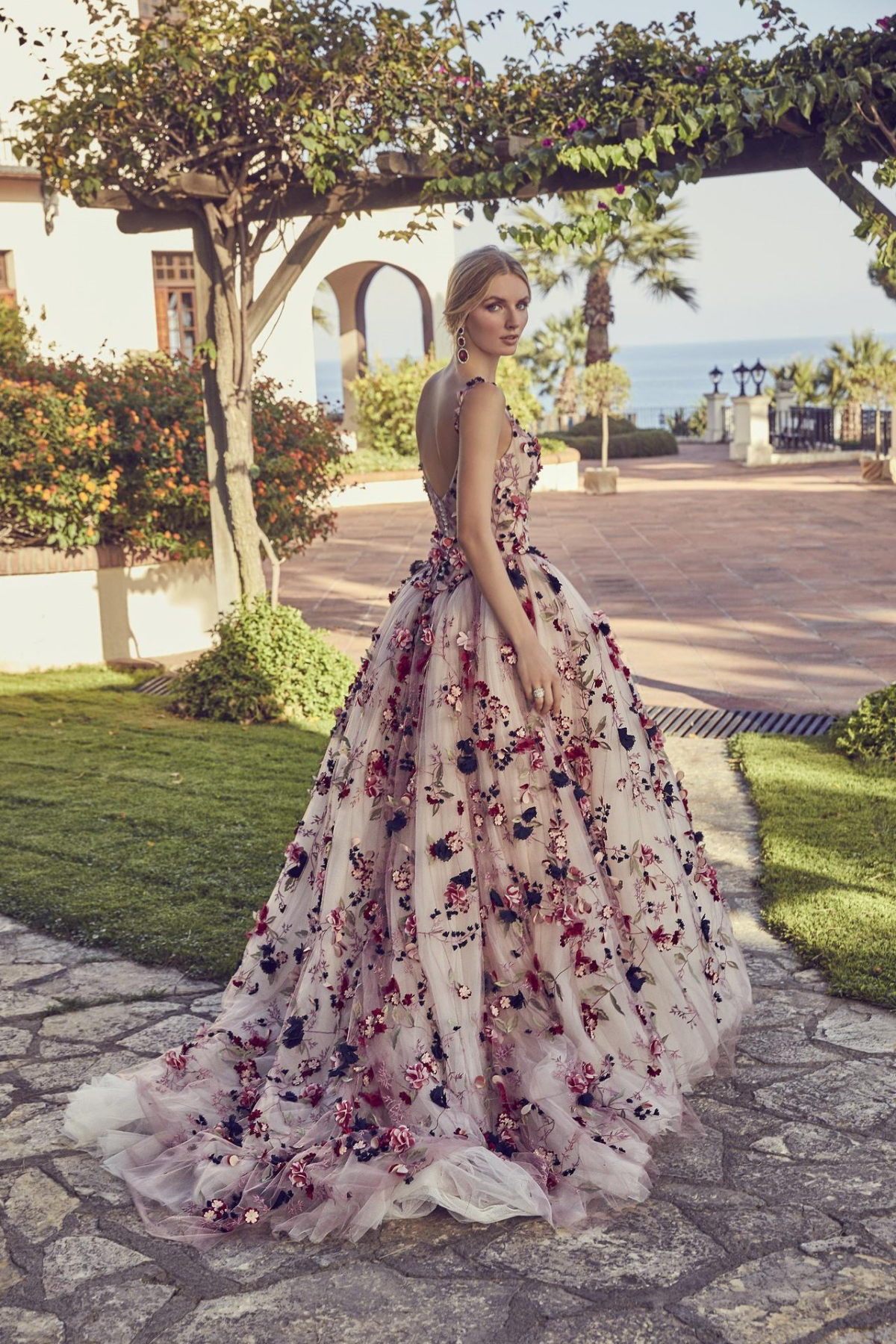
The Color-Changing Trick of the Light (and How to Beat It)
Okay, heads up for a major technical challenge called metamerism. It’s a fancy word for when a color seems to change under different types of light. I learned this lesson the hard way a long time ago. A bride fell in love with a beautiful lavender silk in a studio with warm, cozy lighting. But when she saw the finished gown under the cool fluorescent lights of the workshop, she was horrified—it looked gray!
We quickly took it outside into natural daylight, and boom, it was the perfect lavender again. Her evening reception had warm lighting, so it was all fine in the end, but it was a seriously stressful moment. Now, I insist on what I call the “Three-Light Swatch Test.” It’s non-negotiable.
Here’s how you do it yourself: get a swatch of the fabric you love and take a selfie with it in three different locations:
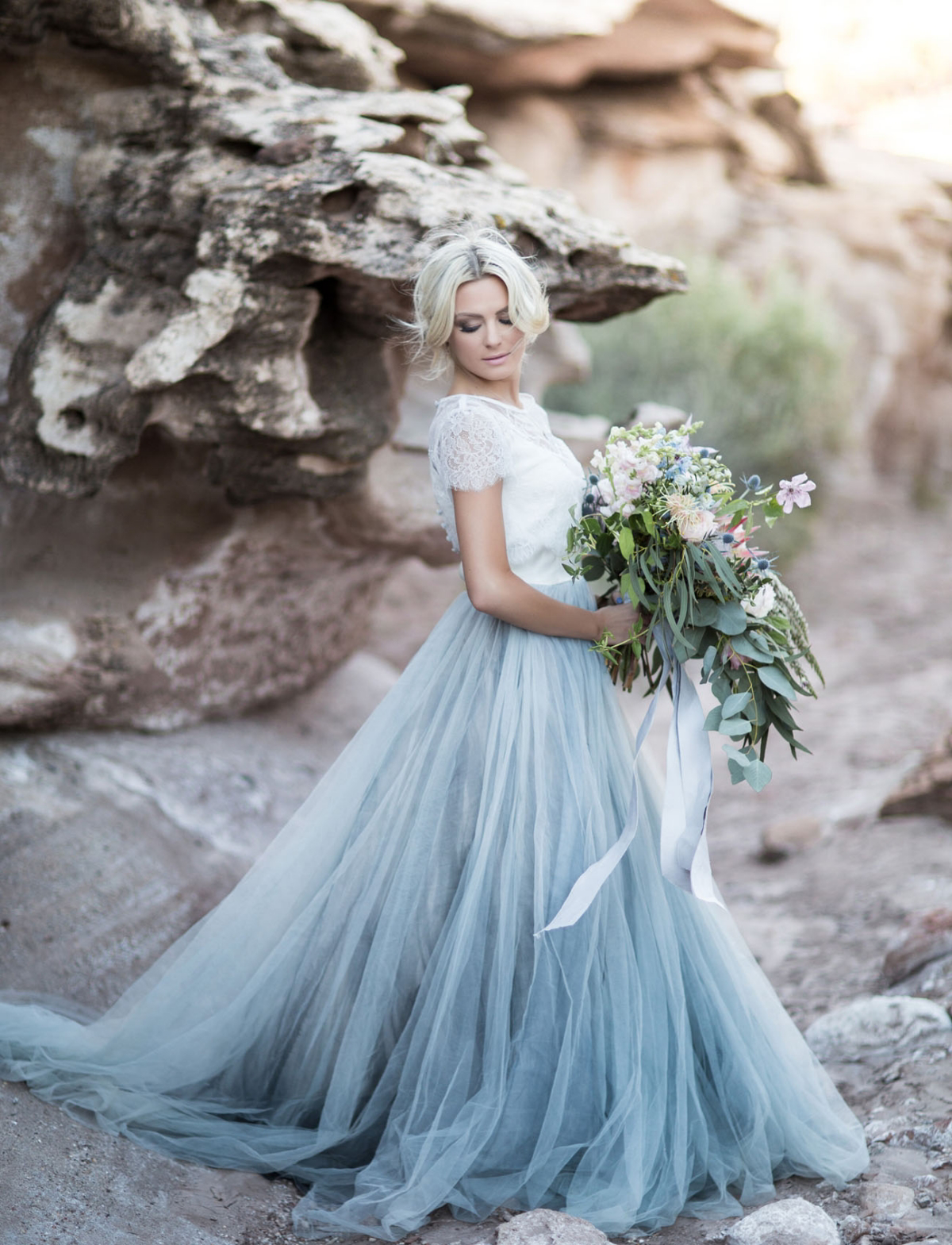
- By a sunny window (natural daylight)
- In a room at night with a warm lamp on (warm indoor light)
- In your bathroom or an office (cool, fluorescent light)
This simple test takes five minutes and can save you from a huge, costly surprise. You need to love how your dress looks in ALL the lighting conditions of your wedding day.
How to Actually Pick Your Perfect Color
You’ve probably heard the generic advice about choosing colors based on “warm” or “cool” undertones. Honestly, it’s a bit too simple. Your hair, your eyes, and the overall contrast in your features matter just as much. The pros use a more hands-on, observational approach.
Instead of thinking in big categories, ask yourself: what do I want this color to do for me? Do you want to look bright and energetic? Soft and romantic? Some colors bring out the gold flecks in your hair, while others make your eyes pop.
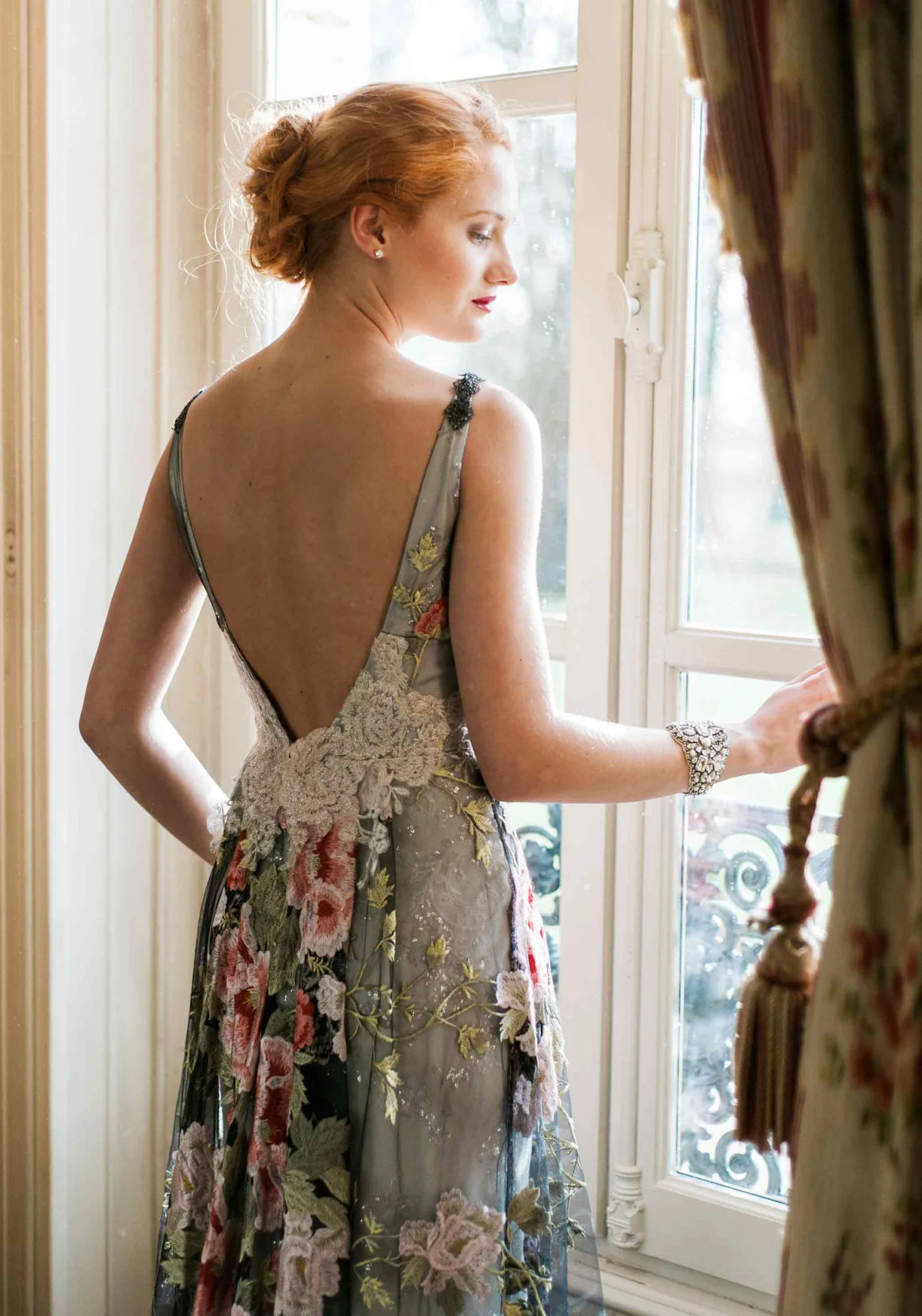
Quick Tip: Go to your closet right now. Pull out the shirt or dress that gets you the most compliments. Drape it under your chin in front of a mirror in good light. See how it brightens your skin and makes your eyes sparkle? That’s your first clue to finding your personal power color!
When you’re at the boutique, ask for the biggest fabric swatch they have. Hold it right up next to your face (ideally with no makeup on) and look at yourself, not just the fabric. Does it make you look vibrant and healthy, or a little tired? A color can be gorgeous on the hanger, but if it drains the life from your face, it’s not the one.
Don’t Forget the Big Picture
Your gown is the star of the show, but it doesn’t exist in a vacuum. Think about your venue’s aesthetic. A dusty rose gown might look incredible in a rustic barn with warm wood tones, but it could feel a bit lost in a stark, modern art gallery. Similarly, a bold emerald green is stunning for a winter wedding with rich decor, but it might feel too heavy for a light, airy spring garden party.
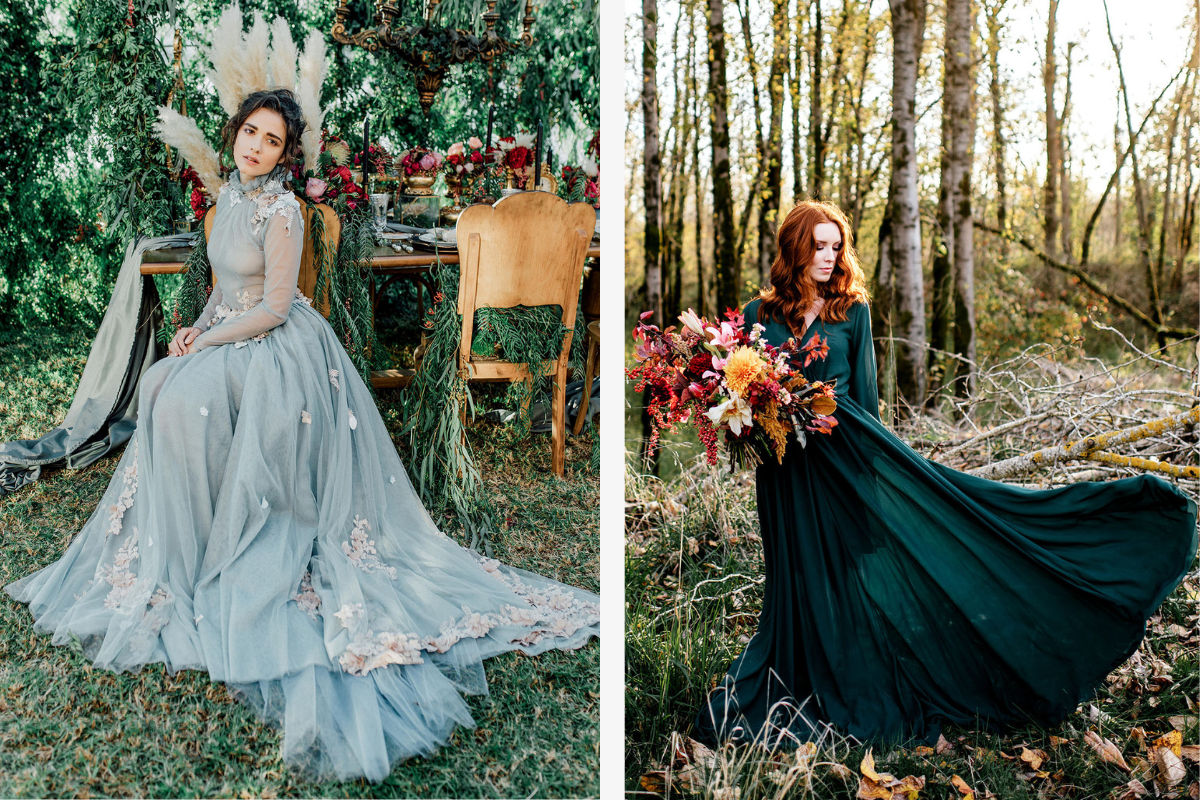
Oh, and talk to your photographer! Dark, saturated colors like navy or burgundy need a photographer who knows how to light them properly. Without the right lighting, all the gorgeous seam details can get lost in shadow. Giving them a heads-up allows them to plan their shots and editing style to make sure your dress looks as amazing in photos as it does in person.
Budget, Timeline, and Finding Your Dress
Let’s talk practicalities. A colored gown isn’t always more expensive, but it can be, and it almost always takes longer to get. Being realistic about this is key.
A standard designer gown can take 6 to 9 months to arrive. If you’re ordering a custom color, the fabric might need to be custom-dyed. That process alone can add another 4 to 8 weeks to your timeline. My best advice? Start shopping 12 to 14 months before your wedding. It sounds like a lot, but it gives you a comfortable buffer for production, shipping, and alterations without any panic.
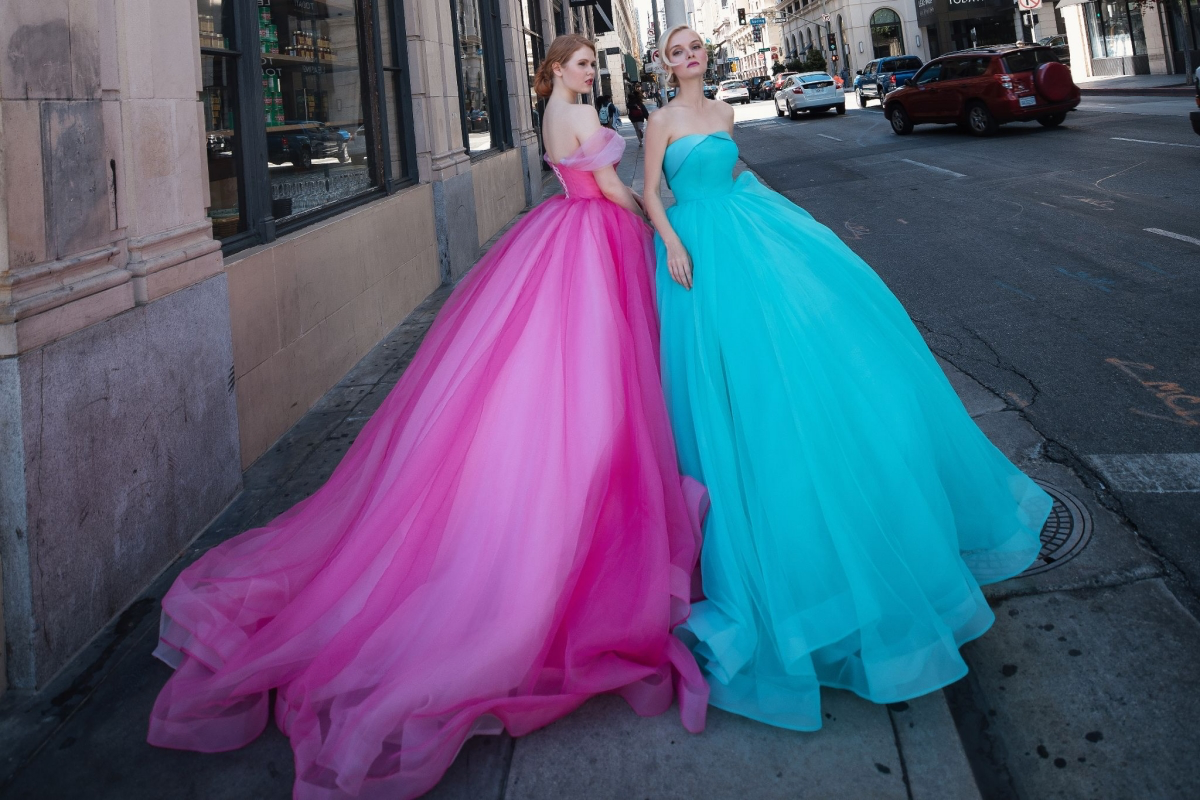
So, what about the cost? A custom color often comes with a surcharge from the designer. This isn’t just a random fee; it covers the specialized process of creating a unique dye lot. Expect a custom color fee to be anywhere from $300 to over $1,000, or a 10-20% upcharge on the gown’s price.
And where do you even find these dresses? You don’t necessarily need a high-fashion couturier. Many brands offer color options. Look for:
- Mid-range boutique brands, which are often celebrated for their beautiful color palettes.
- Accessible lines found at larger bridal retailers like BHLDN or online shops like Needle & Thread, which frequently feature gowns in blush, blue, and metallics.
Styling Your Gorgeous Colored Gown
Okay, you found the dress! Now, how do you accessorize it? The goal is harmony and balance, not just matching everything perfectly.
For veils, a matching colored veil can sometimes look a bit dated. Instead, think about a complementary neutral. For soft gowns (like blush or light blue), a soft ivory or diamond white tulle veil is usually perfect. For bold gowns (like emerald or navy), you could go with a simple, sheer ivory veil for contrast or skip the veil entirely for a stunning jeweled headpiece.
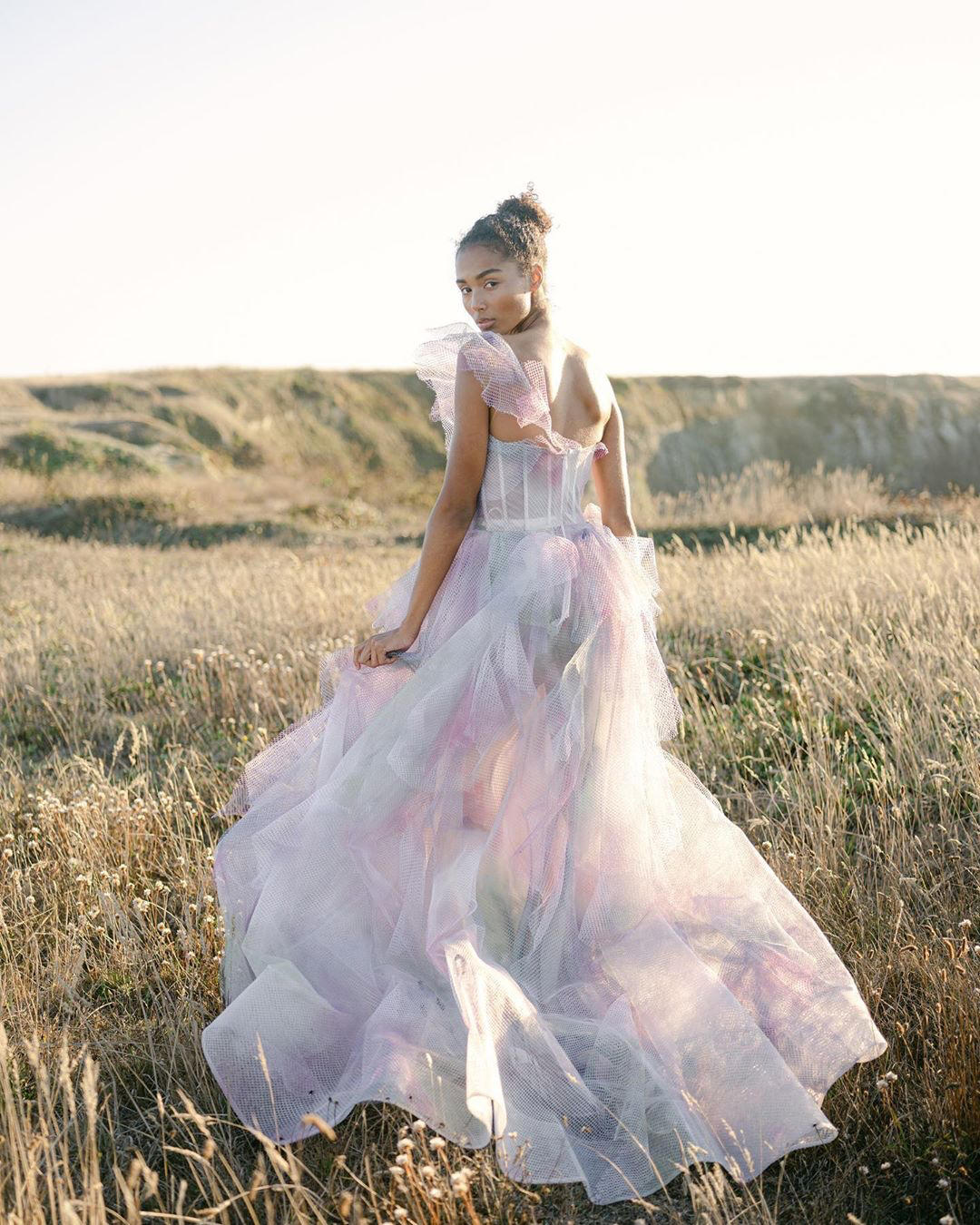
Your bouquet is your best accessory. Work with your florist to create a palette that complements your dress without being too matchy-matchy. For a bride in a dusty blue gown, imagine a bouquet with no blue flowers at all. Instead, it’s full of creamy white peonies, silvery dusty miller leaves, and touches of deep burgundy. The contrast is stunning!
Coordinating the Wedding Party
This is a big one. If you’re in a colored gown, what does everyone else wear? The key is to coordinate tones, not match colors. If you’re wearing a deep burgundy, your partner could rock a sharp navy suit instead of black for a super rich, modern look. Or a charcoal gray suit would also be fantastic. For bridesmaids, you could put them in a complementary neutral, like a soft champagne or a rich charcoal, or choose a lighter shade in the same color family as your dress.
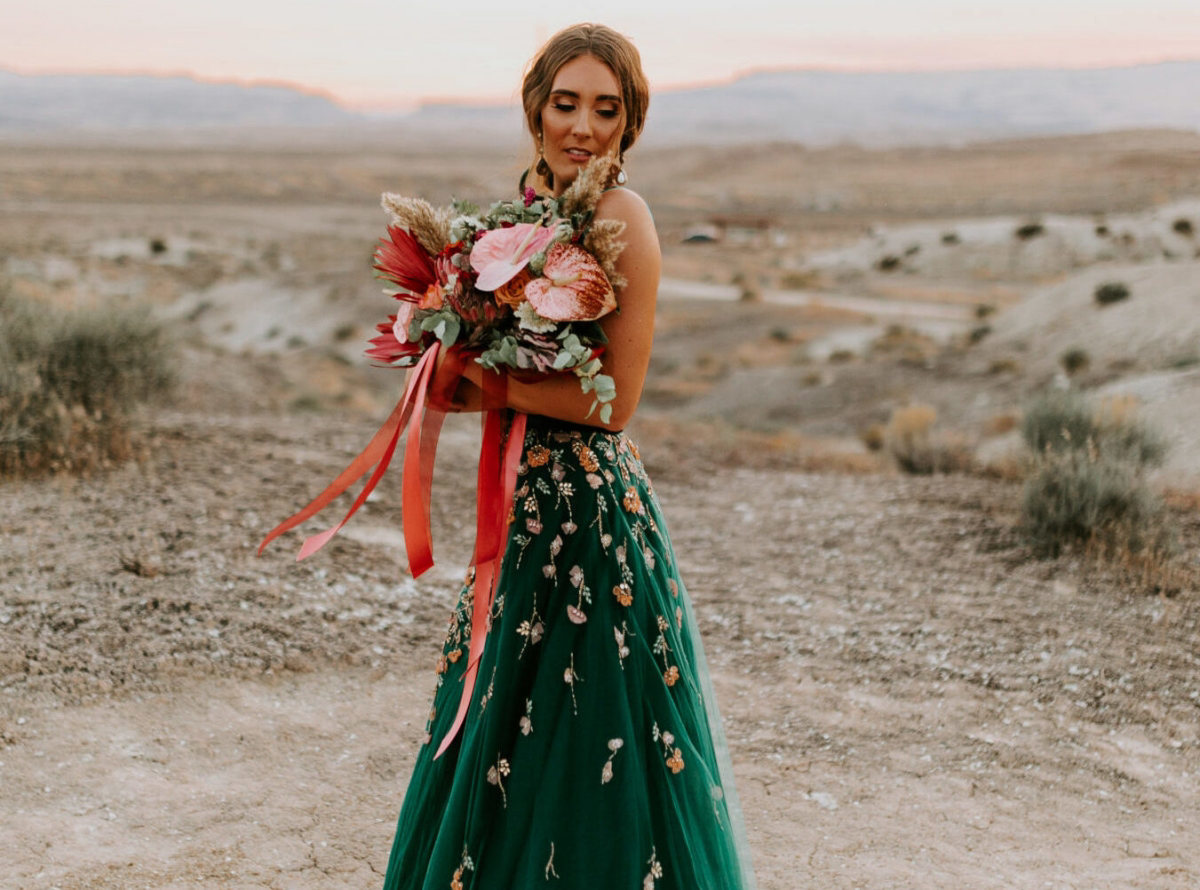
Dealing with Doubters and Dress Care
Let’s be honest: you might get some pushback from family about not wearing white. It’s a valid worry. The best approach? Be confident in your choice first. Find your dress, fall in love with it, and then invite the important people to a later fitting. When they see you in the gown, looking radiant and happy, their perspective often changes completely. Remember, it’s often easier to win them over with your joy than to win the argument beforehand.
After the wedding, your dress needs special care. You can’t take colored silk to a standard dry cleaner; their chemicals can strip the color. You need to find a wedding gown preservation specialist with experience in colored garments. And a final word of warning: never, ever try to spot-clean the dress yourself, especially with water. On fabrics like silk, water will leave a permanent ring that’s worse than the original spot. Just blot gently and leave it to the pros.
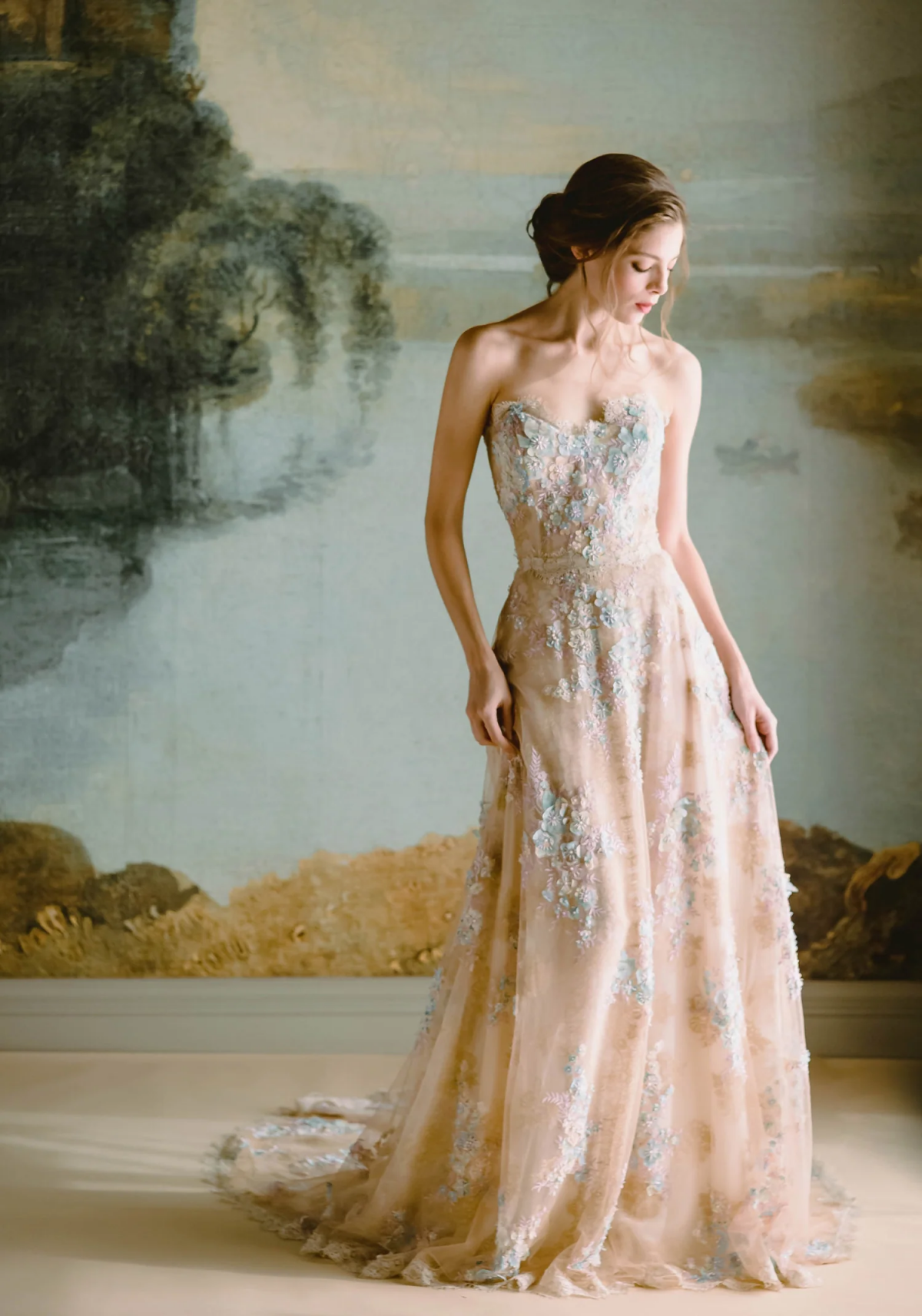
At the end of the day, choosing a wedding gown is incredibly personal. White is beautiful and timeless, but if your heart is pulling you toward a soft green, a rich gold, or a dramatic black, you should absolutely listen to it. This is about creating new traditions that feel right for you.
Galerie d’inspiration
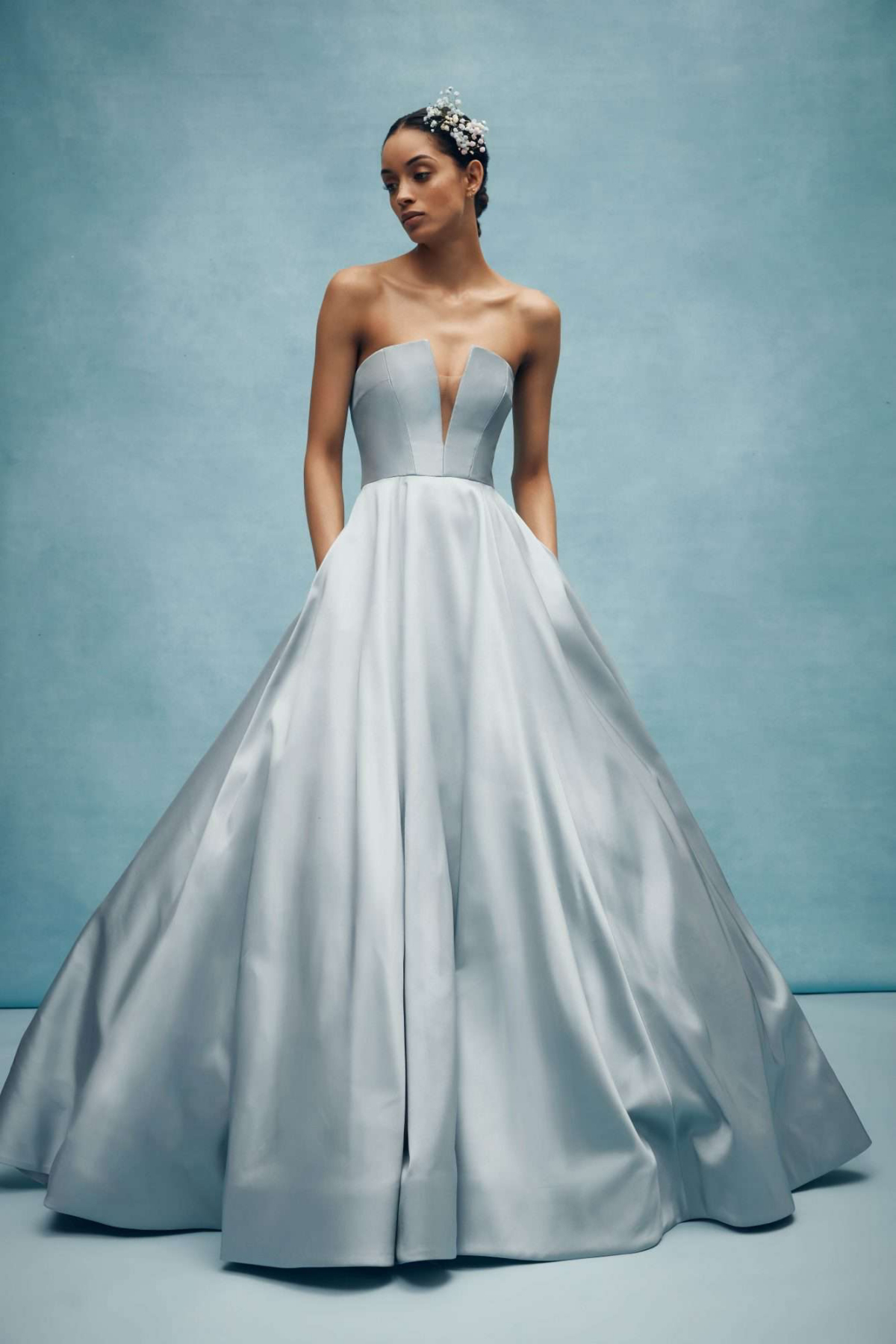
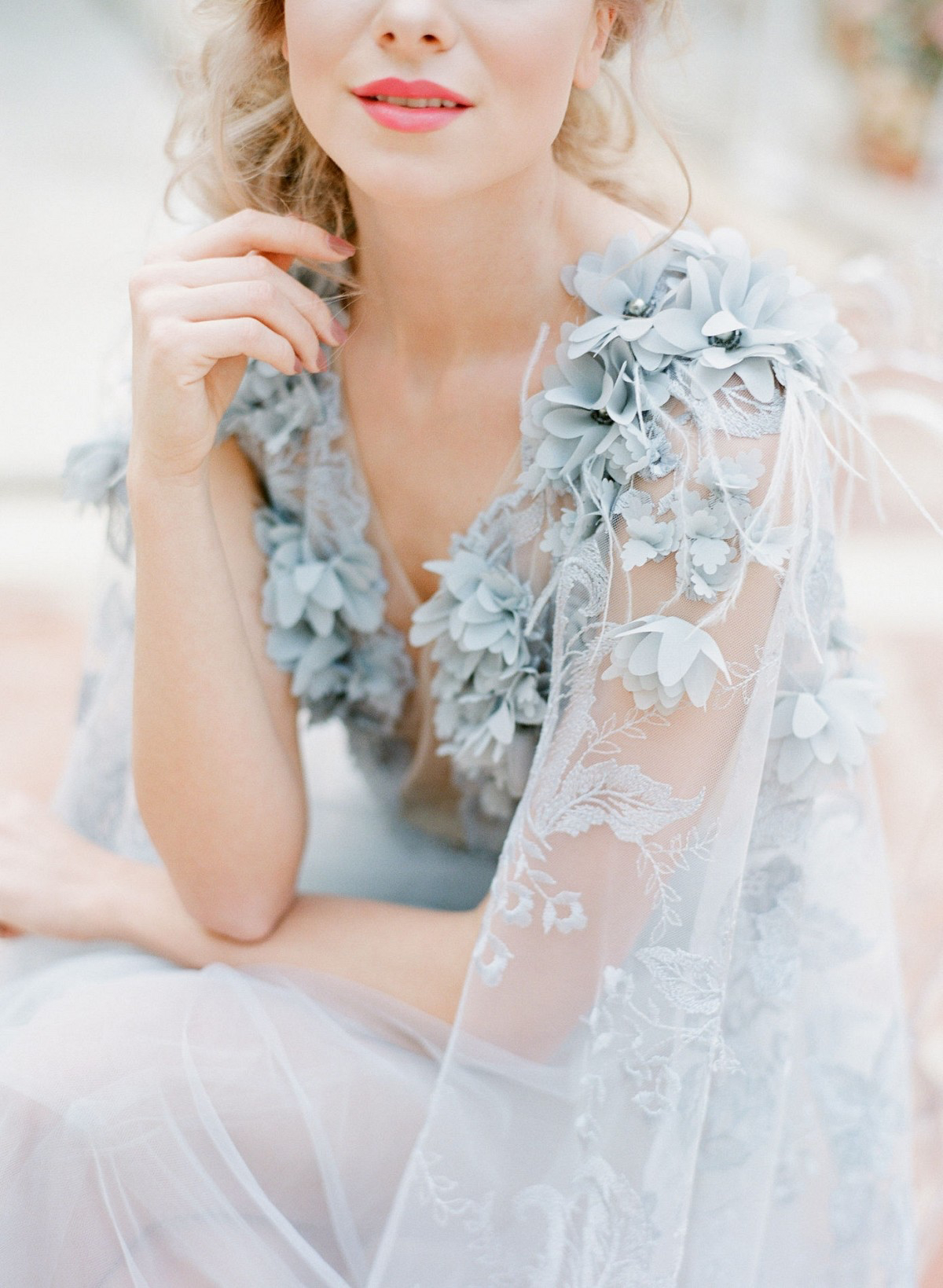
When choosing a colored gown, your floral bouquet becomes a critical accessory. Don’t just match the colors—create a dialogue. For a dusty blue dress, think about contrasting warmth with peach ranunculus and creamy roses. For a deep emerald gown, a bouquet of pure white anemones with dark centers creates a striking, modern look.
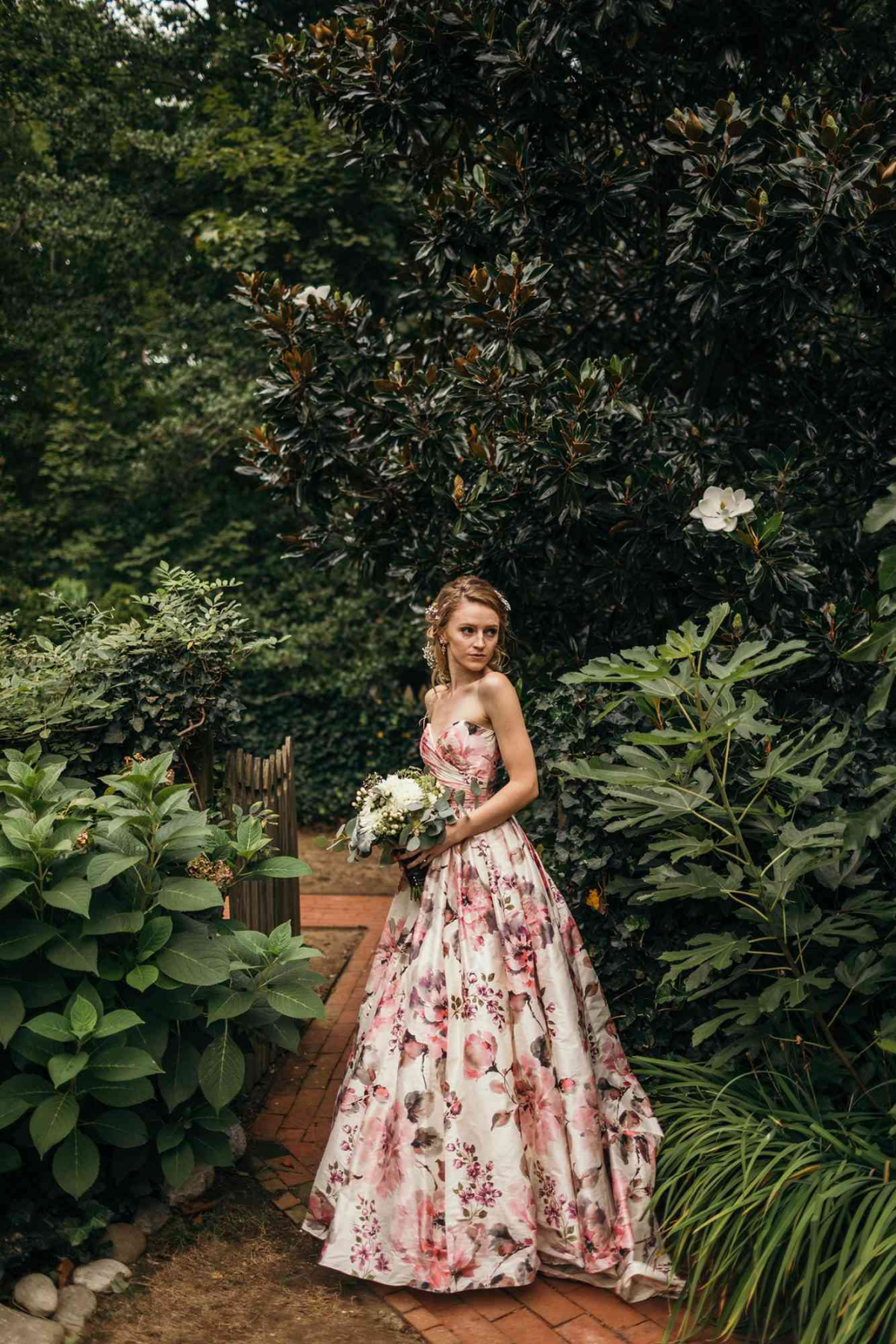
- Create stunning visual texture in your wedding photos.
- Perfectly complement your wedding’s unique theme and color story.
- Feel deeply, authentically yourself on your most important day.
The secret? Choosing a color with personal history. Perhaps the soft lavender of the hydrangeas in your grandmother’s garden, or the deep sea-green from your first vacation together.
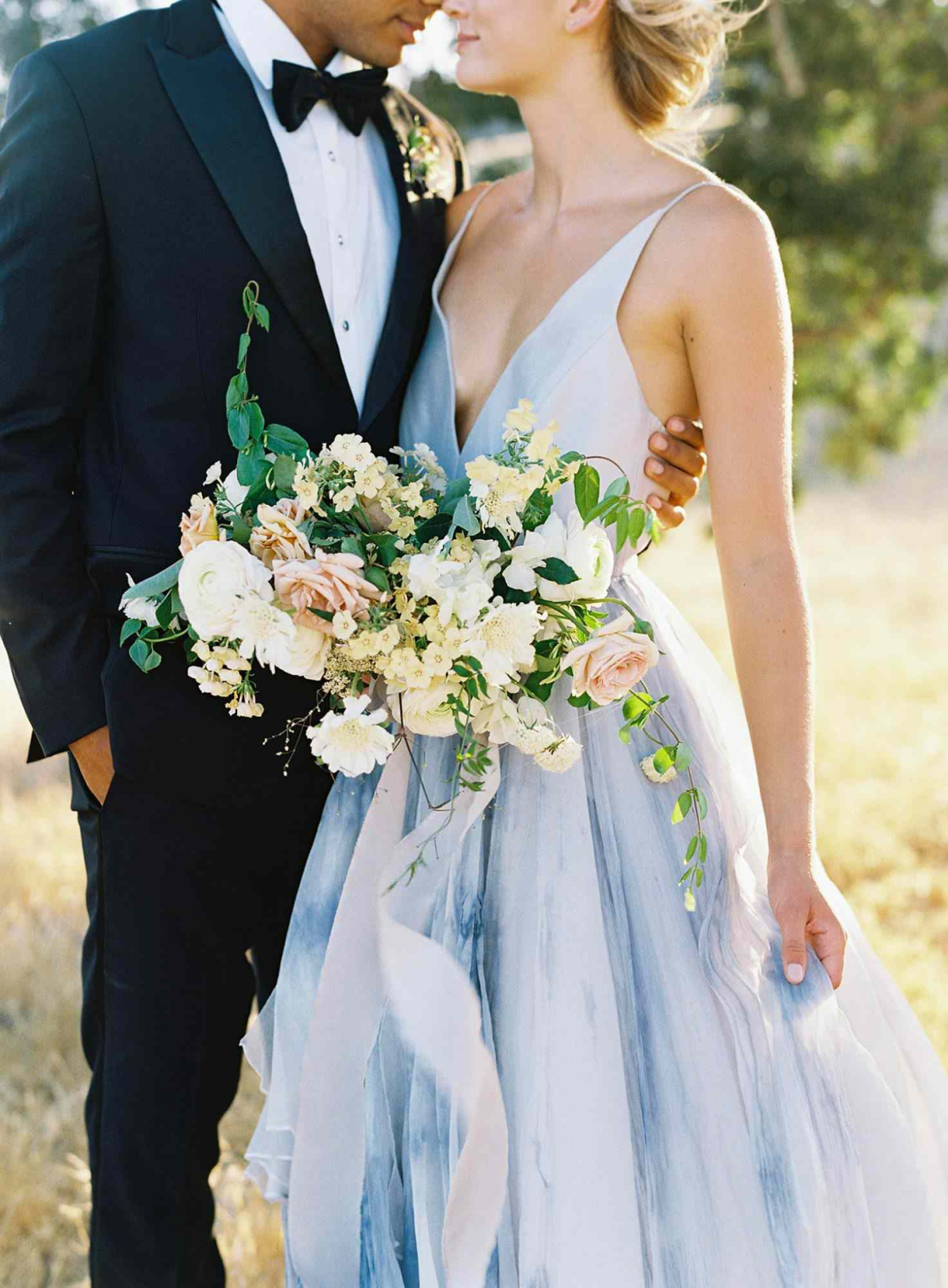
Over 30% of modern brides are now choosing wedding dresses in shades other than white, according to recent bridal market reports.
This isn’t just a trend; it’s a fundamental shift towards personalization. It means designers are offering more options than ever, and boutiques are more open to stocking gowns in blush, champagne, blue, and even black. Your dream color is more accessible than you think.
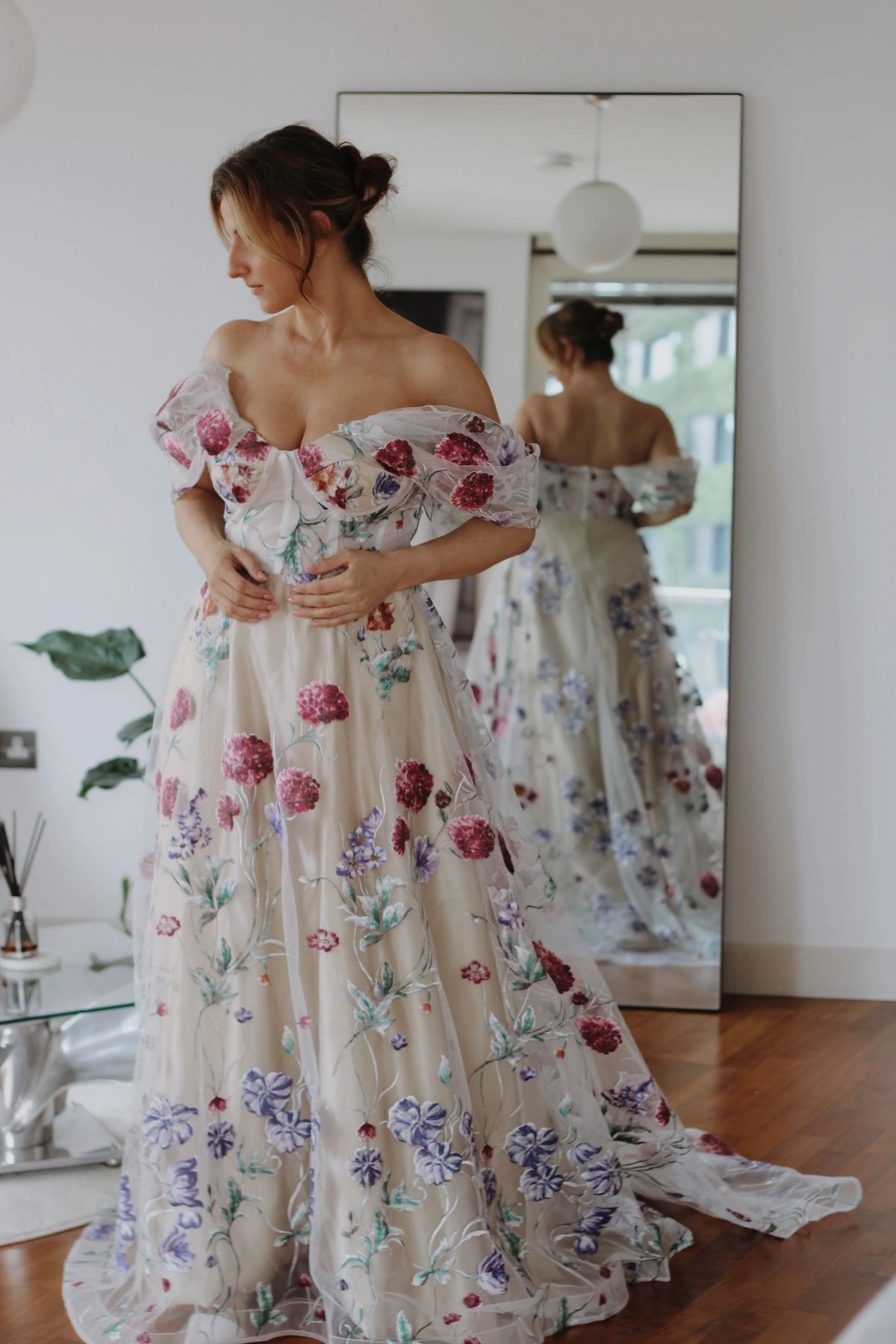
Thinking about a bold color like black or scarlet?
Lean into the drama. A black gown, like the iconic ones from Vera Wang’s collections, isn’t just ‘goth’; it’s the epitome of chic sophistication. Pair it with diamond jewelry and a sleek updo for a black-tie affair. A scarlet red dress channels passion and confidence; keep accessories minimal with gold accents and let the color do all the talking. It’s about owning the statement.
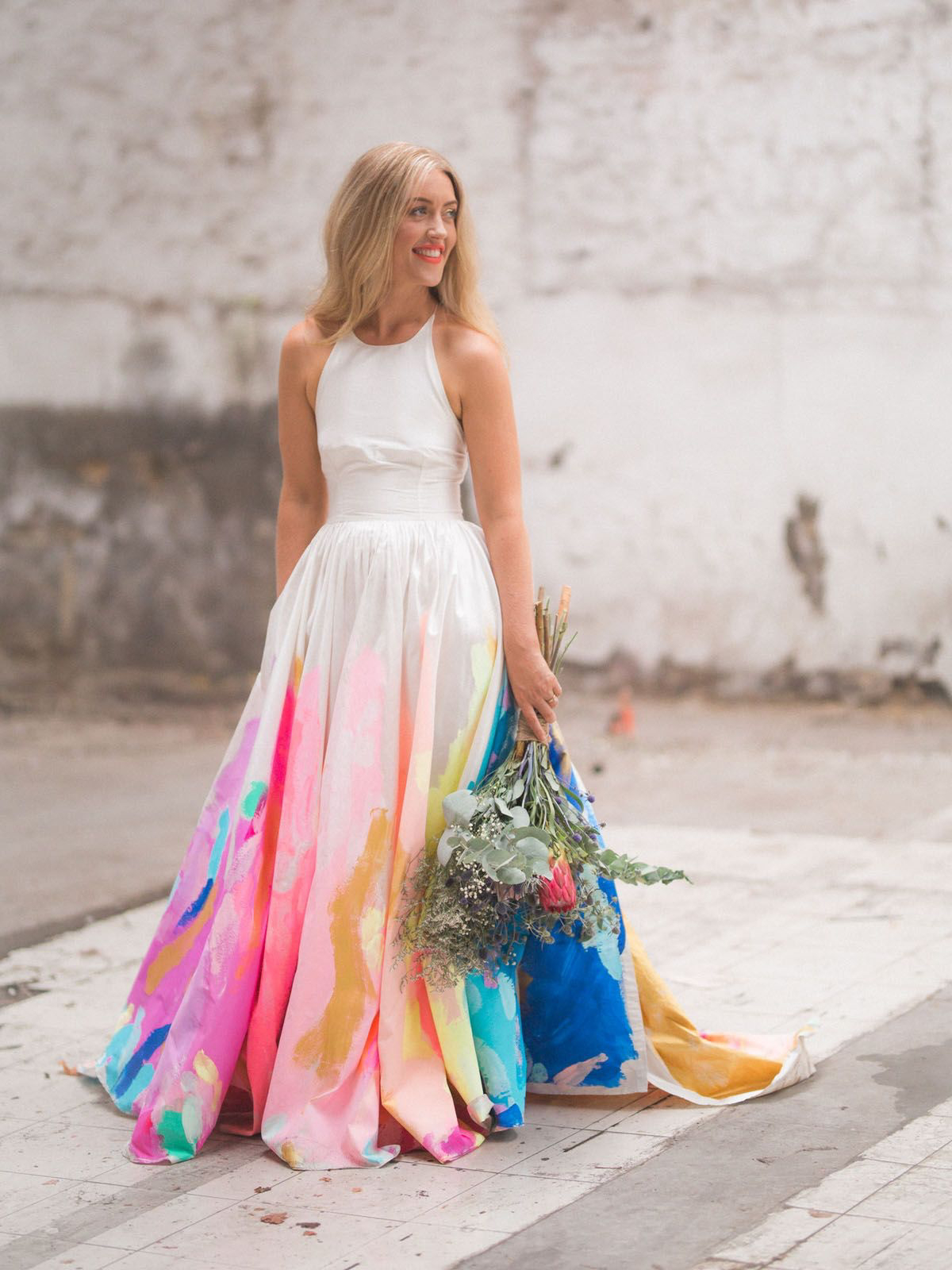
Don’t forget the ‘underglow.’ The color of your dress’s lining or petticoat can subtly transform its appearance. A blush gown lined in a warmer champagne tone will radiate a golden glow, while the same blush over a simple ivory lining will feel cooler and pinker. It’s a custom touch that adds incredible depth.
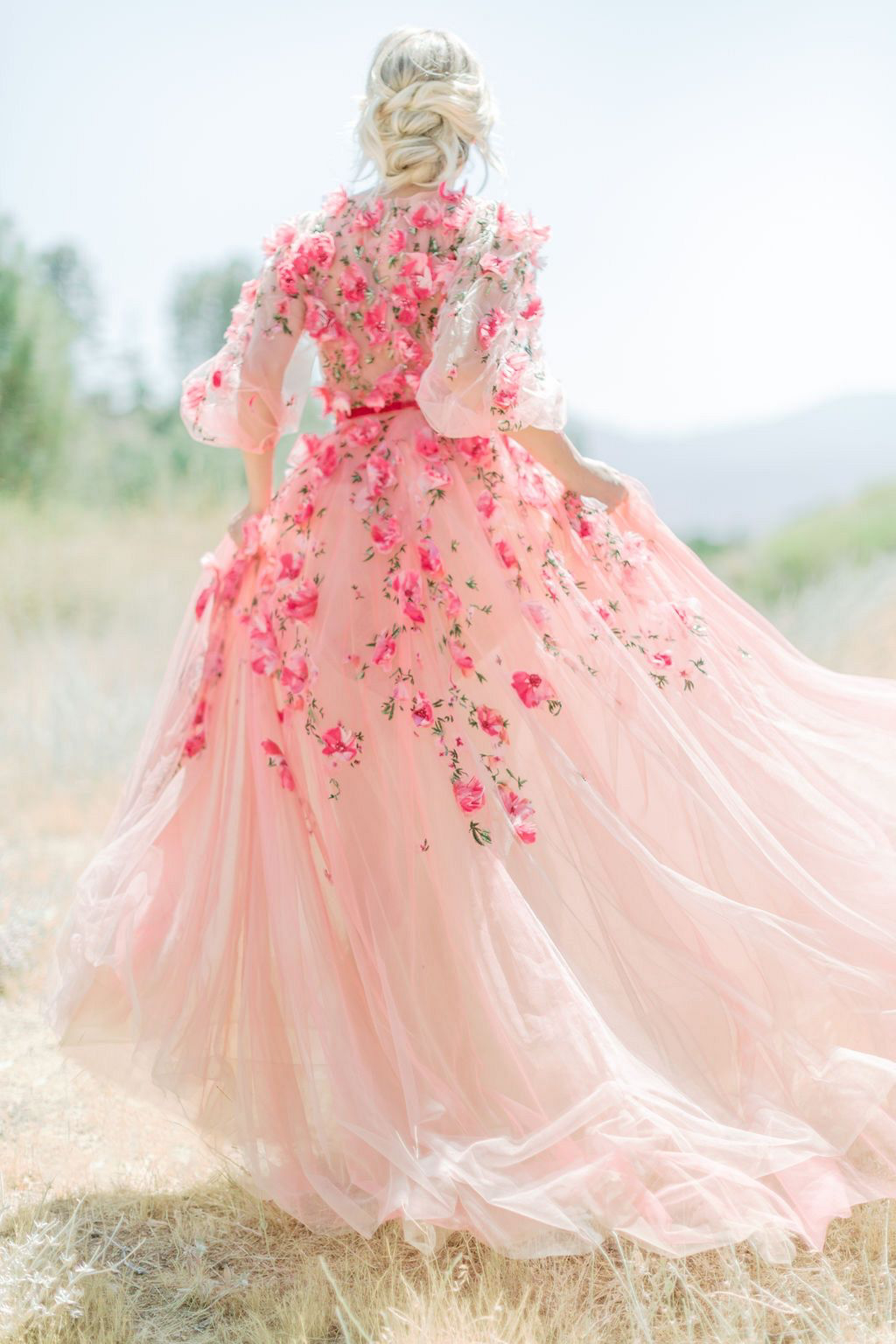
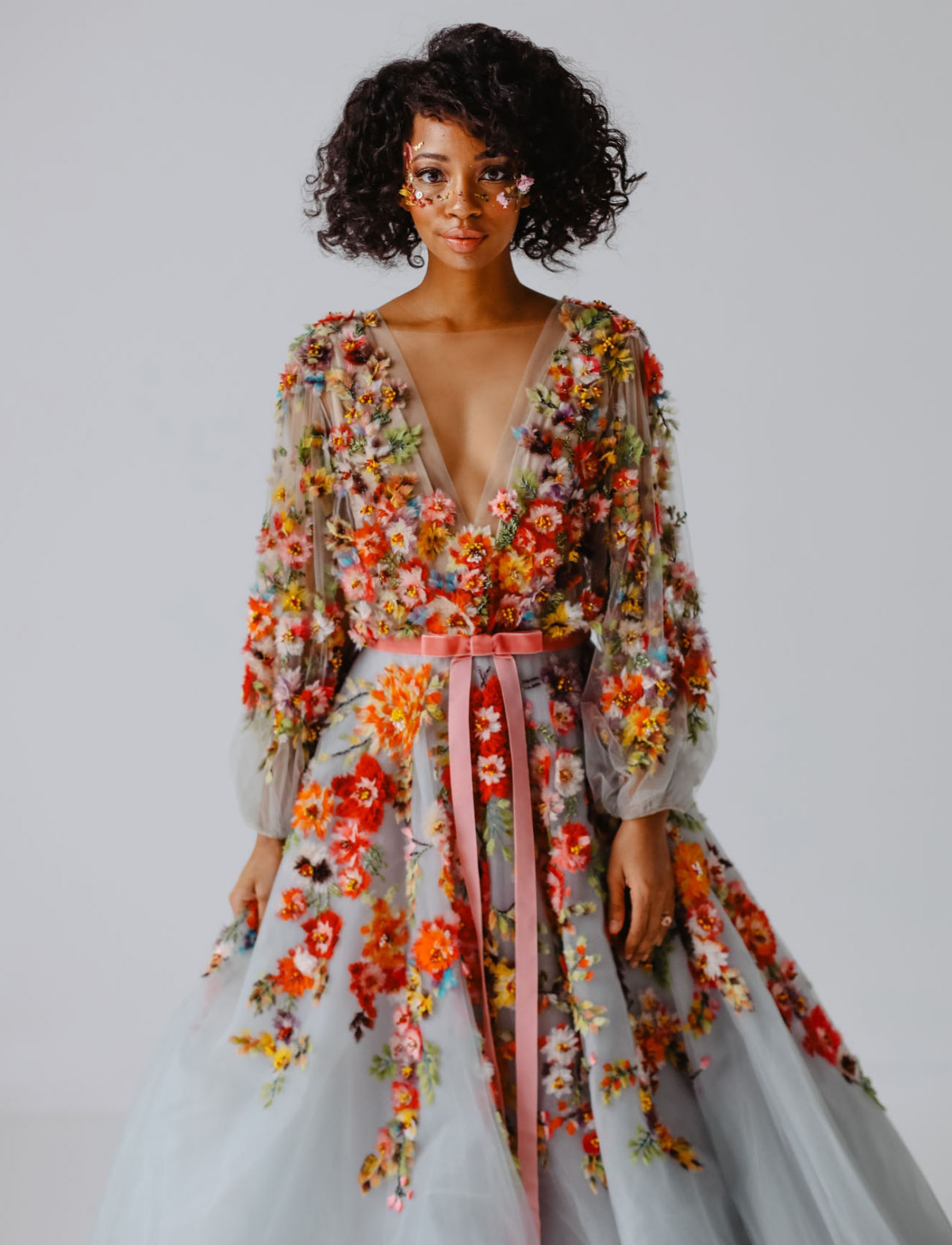
Bridal Designer Gown: Crafted by brands like Monique Lhuillier or Marchesa, these are made-to-order with bridal construction, often featuring intricate details like colored 3D floral appliqués or custom embroidery.
High-Fashion Evening Gown: An off-the-rack masterpiece from a luxury brand like Alexander McQueen or Elie Saab can serve as a wedding dress, offering avant-garde style and color, sometimes at a more accessible price point than bridal couture.
The choice depends on whether you prioritize traditional bridal structure or high-fashion editorial flair.
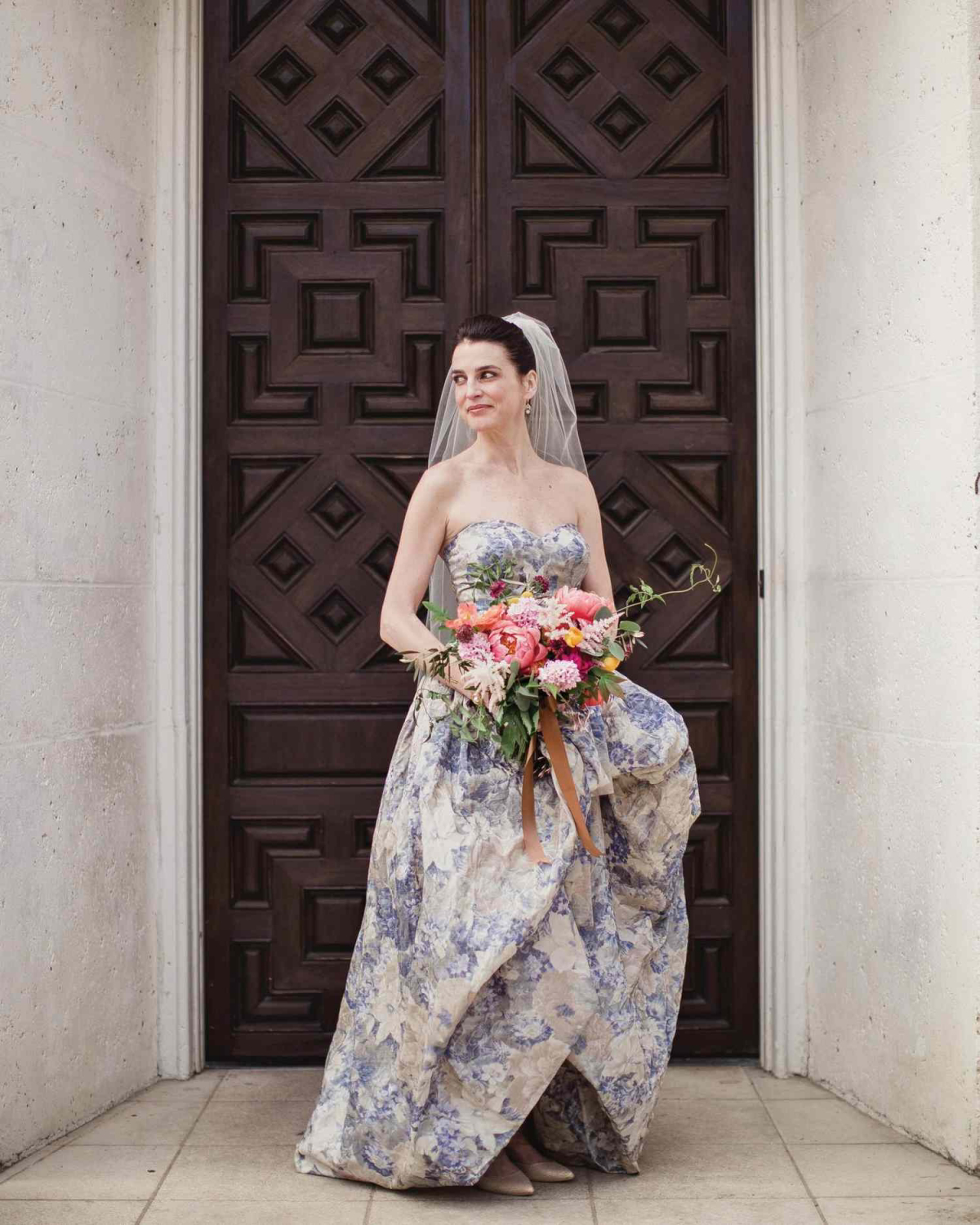
The tradition of a white wedding dress was largely popularized by Queen Victoria in 1840. Before her, brides simply wore their best dress, which came in a variety of colors.
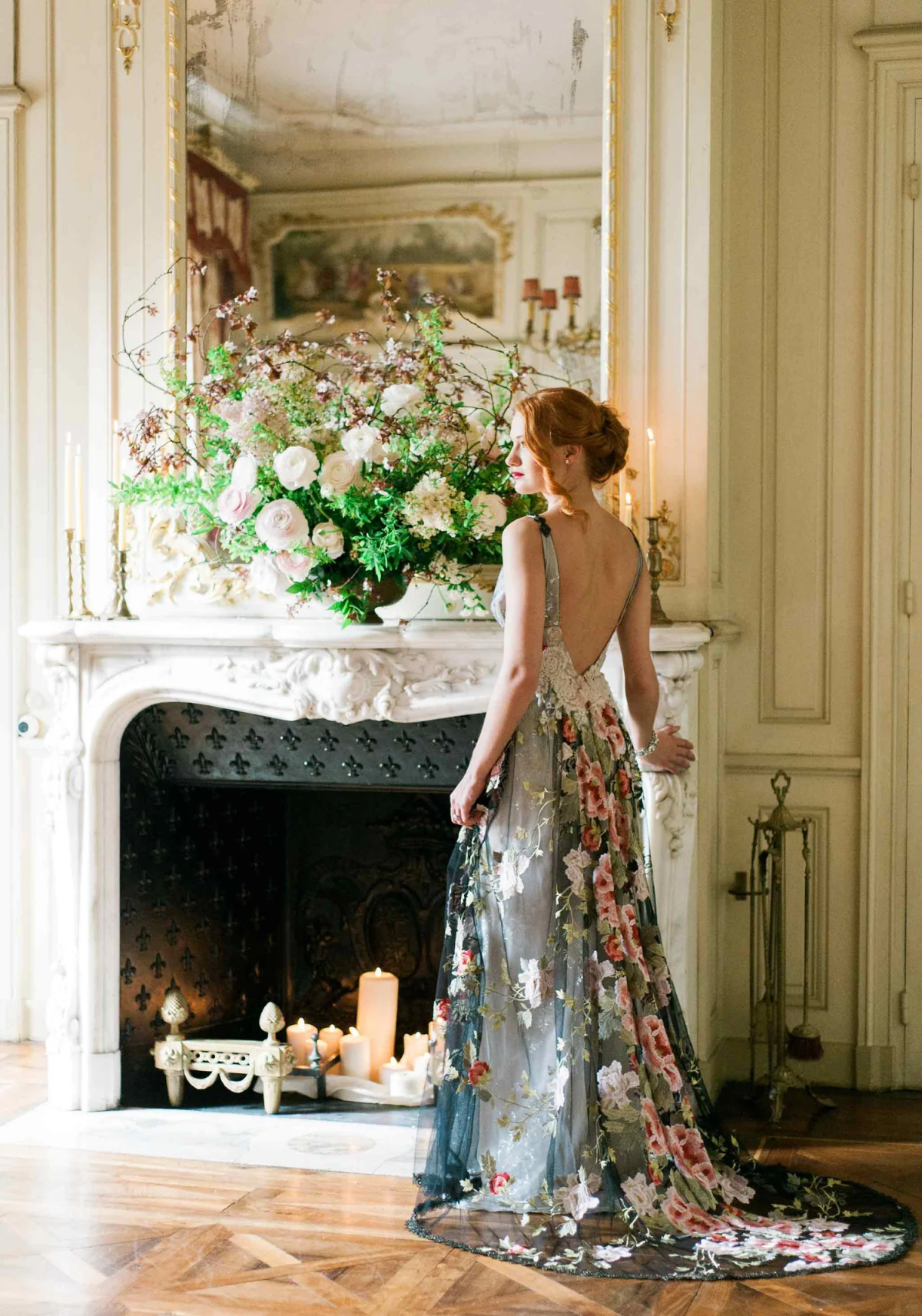
A crucial detail: Your skin’s undertone. A color that looks stunning in a magazine might not harmonize with your complexion. As a rule of thumb, cool undertones (with hints of blue or pink) are flattered by jewel tones like sapphire, emerald, and cool pastels. Warm undertones (with hints of yellow or gold) glow in earthy tones, champagne, peach, and warm reds.
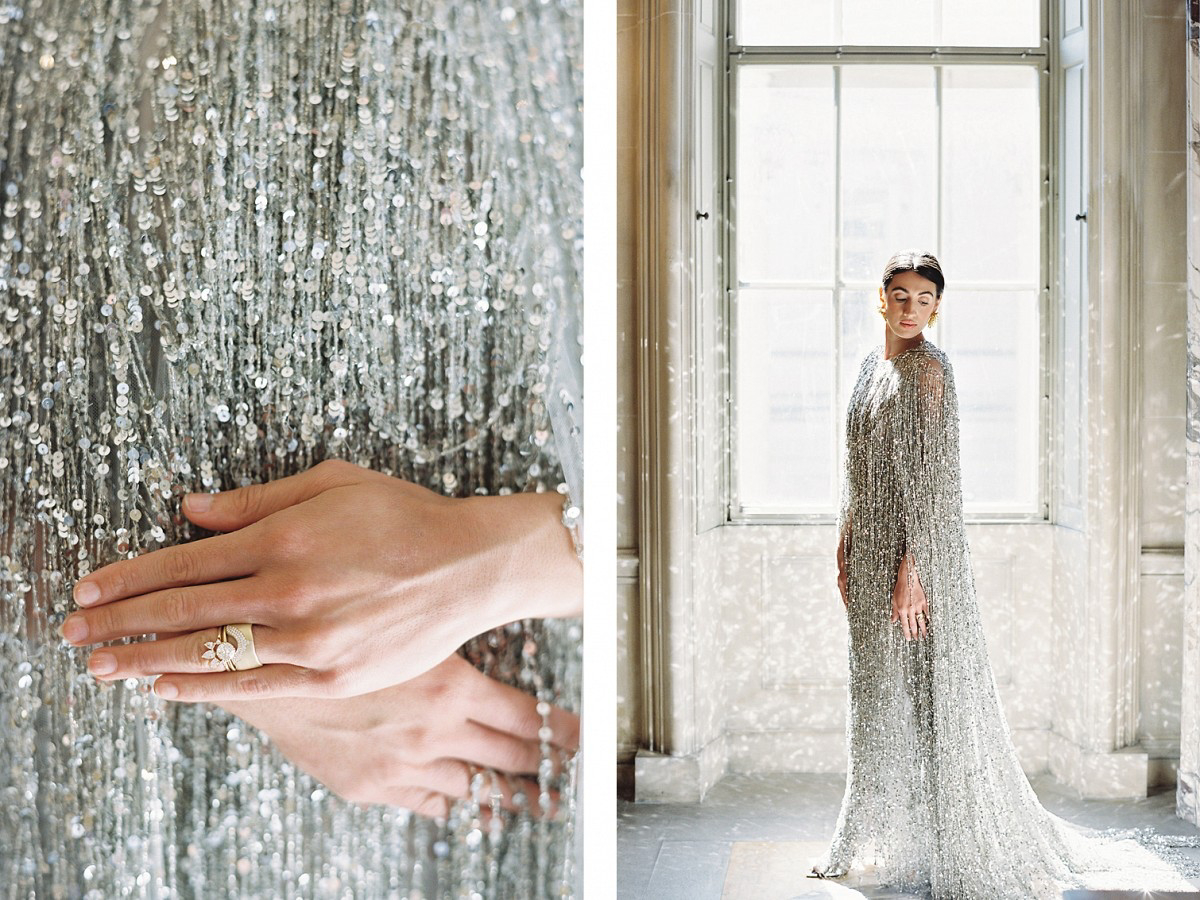
Before committing to a colored gown, consider your wedding party’s attire. Coordinating with a non-white dress requires a thoughtful eye.
- For a soft pastel dress (blush, lavender): Consider dressing bridesmaids in elegant neutrals like dove grey, champagne, or even a crisp white.
- For a bold jewel-toned dress (emerald, ruby): A mix of metallic or deep neutral tones for the wedding party will complement without competing.
- For a patterned or floral dress: Pull a minor color from your gown’s pattern for the bridesmaids’ dresses to create a cohesive, sophisticated look.
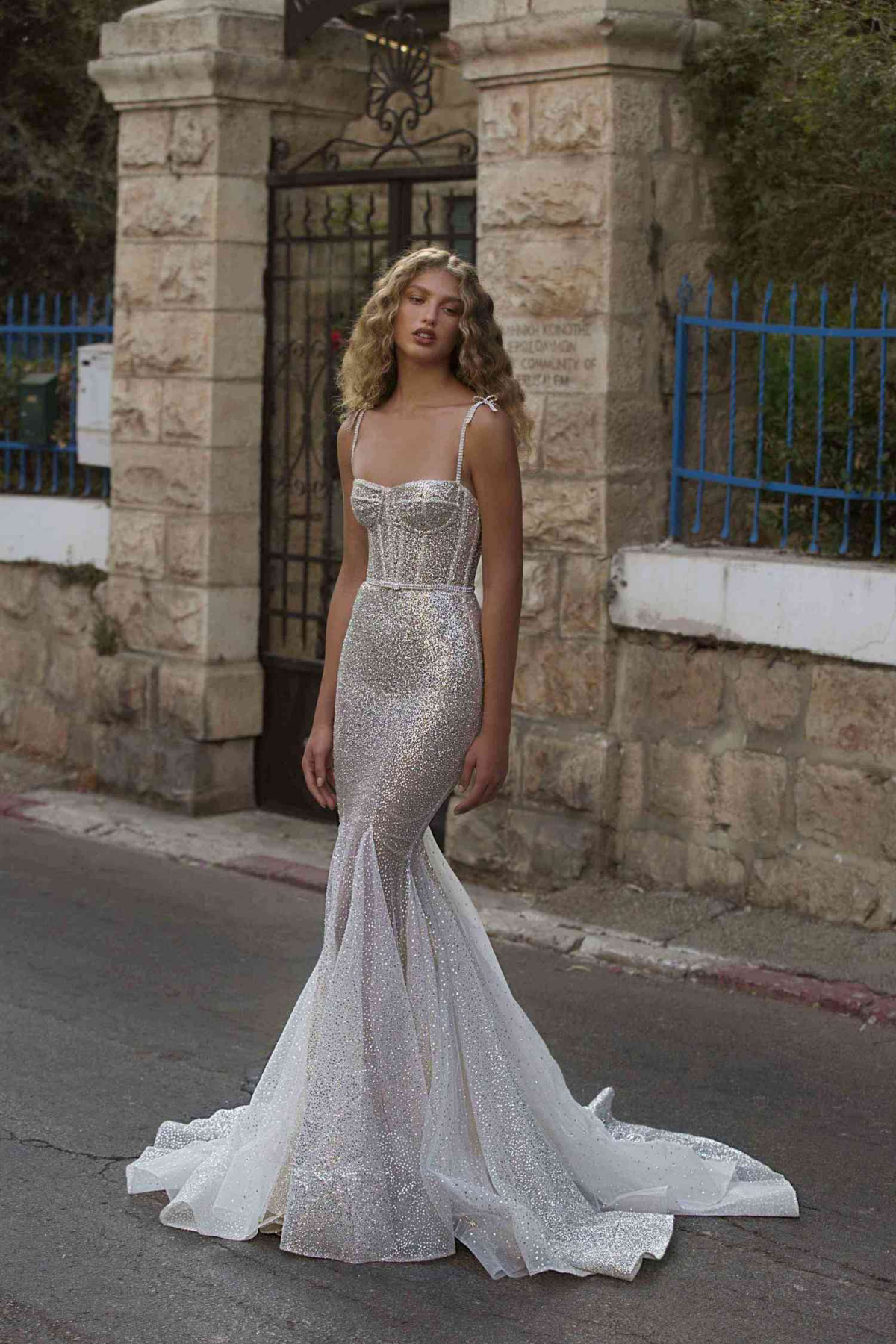
Worried about preserving the vibrancy of a colored gown? The key is professional care. When you take it to a specialist cleaner, be sure to point out that it’s a colored fabric. They will likely test a small, hidden area for dye-fastness before proceeding with the full cleaning and preservation process to ensure the color remains as rich as the day you wore it.
Not ready for a fully colored gown but want to dip your toes in the water? A hint of color can be just as impactful. Think about a custom hand-painted veil with delicate florals, a luxurious velvet sash in a deep burgundy or forest green, or even a crinoline under-layer in a surprise color like baby blue that flashes as you walk and dance.

